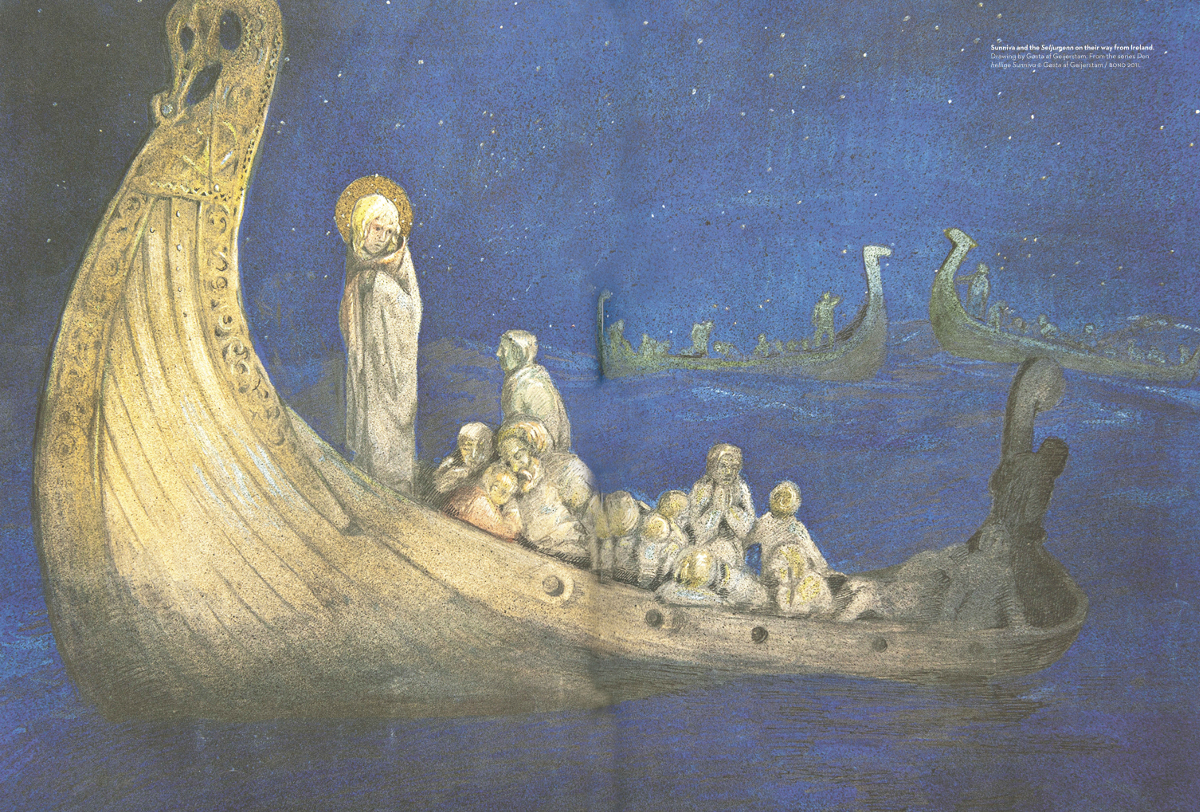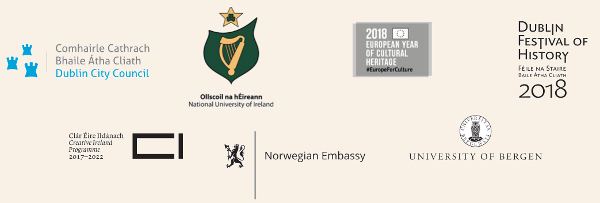10.10.2018

Sunniva and the Seljumen on their way from Ireland
Drawing by Gösta af Geijerstam. From the series Den hellige Sunniva
©Gösta af Geijerstam, Bono Norway/IVARO Dublin, 2018
Click image to enlarge
Dublin Festival of History:
Viking Symposium and Lecture
Irish and Norse relations in the Viking age were celebrated last week as part of the 2018 Dublin Festival of History, with a series of free public events on the 4 and 5 October including a symposium entitled Our Friends from the North? Irish-Norse Relations in the Viking Age at Wood Quay Venue; a lecture by Norwegian scholar Jan Erik Rekdal on The legend of St. Sunniva and its representation of the Christianisation of Norway in the Mansion House; and the launch of a touring library exhibition.
Following the symposium, Christ Church Cathedral held an ecumenical service at evensong with Bishop Halvor of Bergen in celebration of St Sunniva, patron saint of Bergen and commemorating the 950 year anniversary of the establishment of a bishopric in western Norway in 1068. The service offered a multilingual medley of Irish prayers, Norwegian folk songs, choral pieces sung by the Cathedral Choir, and the very special first performance of a new anthem, the Hymn to St Sunniva.
The celebration was a collaborative project between partners Dublin City Council working through the City Archaeologist and Dublin City Libraries, the National University of Ireland, the University of Bergen, and the Norwegian Embassy in Ireland. This exciting collaboration was part of the European Year of Cultural Heritage 2018 and the Dublin Festival of History, supported by Creative Ireland.
To continue this collaboration, the academic coordinators Dr Emer Purcell, NUI, and Dr Ruth Johnson, Dublin City Archaeologist, and Irish scholars Dr Edel Breathnach, John Sheehan and Dr Alex O’Hara will present papers at Bergen’s medieval conference, I Vesterled – Westward bound on the 17 and 18 of Octoberin the University Aula at the University Museum in Bergen. By presenting research in new and different contexts through an exchange of papers, they will aim to further raise awareness and knowledge of Irish-Norse connections.
|
|
|
|
|
|
Exhibition - Treasures from the Grave: exploring Irish Norse connections through artefacts in the University Museum of Bergen
The exhibition provides an introduction to the archaeology of western Norway in the Viking Age and highlights connections with Ireland. Nine panels cover topics such as the Viking Age in Norway, home life in western Norway, furnished female burials containing Irish artefacts, the contents of a chieftain’s burial, towns and trade, the influence of Christianity and conversion, shared Viking art styles and the legend of St Sunniva. The text and images were provided by a team of archaeologists from the University of Bergen. The exhibit was launched at Wood Quay and went on display on 6 October at the Print Works in Dublin Castle, before touring the city libraries and Civic Offices.
St Sunniva - patron Saint of Bergen and western Norway
The legend of St Sunniva, as told in the sagas and literary sources, concerns the beautiful daughter of an Irish king, said to have lived in late tenth century Ireland. On her father’s death, Sunniva succeeded him as the ruler of the territory and was pursued by a pagan Viking leader for her hand in marriage. Being a devout Christian she refused to marry, and the Viking proceeded to attack and ravage her kingdom. Sunniva and her subjects then put to sea. Trusting in God to guide and steer their course, they came to land safely on the island of Selje on the western coast of Norway. On hearing of the newcomers, the local people called upon Håkon Jarl to attack them with his army. Sunniva and the men and women of Selje sought refuge in the island’s caves and prayed for their eternal salvation, where they were killed by falling rocks. Not long afterwards, a beautiful light was often seen at Selje. The recently converted King Olaf and Bishop Sigurd travelled to Selja to investigate the strange events and they found the body of Sunniva intact. In 1170 her remains were transferred to a shrine in Bergen.
References
St Sunniva and the Holy Shrine, by Alf Tore Hommedal & Åslaug Ommundsen, Bergen City Museum, Bryggens Museum Bergen 2012.
‘Parallels between the Norwegian Legend of St Sunniva and Irish Voyage Tales’ by Jan Erik Rekdal in Clarke, Ní Mhaonaigh & Ó Floinn (eds.) Ireland and Scandinavia in the Early Viking Age, Dublin 1998.
‘A holy cave and womb: the sanctuary on the island of Selja and the birth of the first Norwegian saints’, by Alf Tore Hommedal in Bergsvik, Knut Andreas & Dowd, Marion (eds.) Caves and ritual in Medieval Europe, AD 500-1500, Oxford & Philadelphia 2018.
























